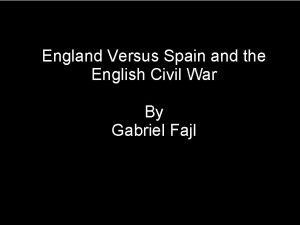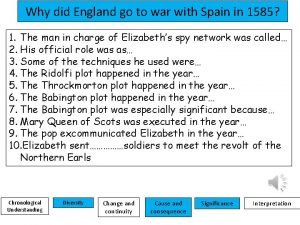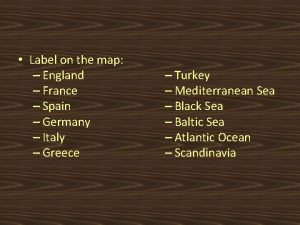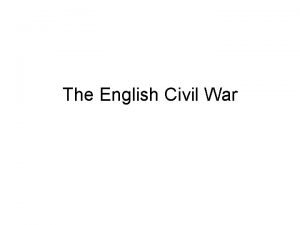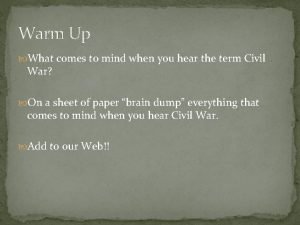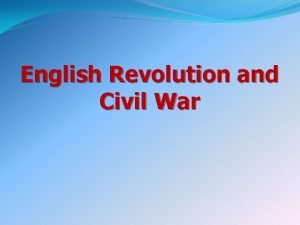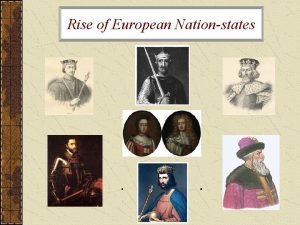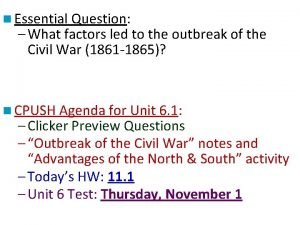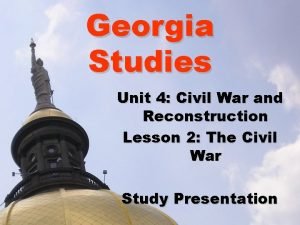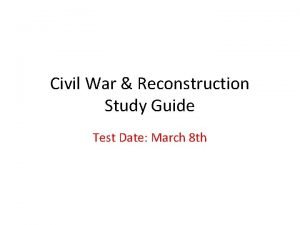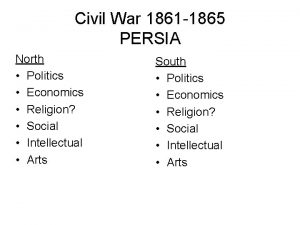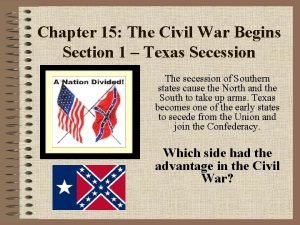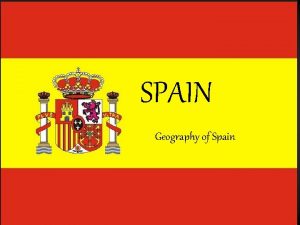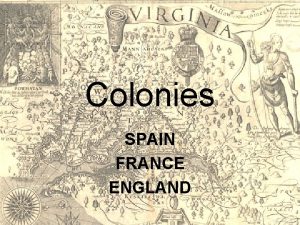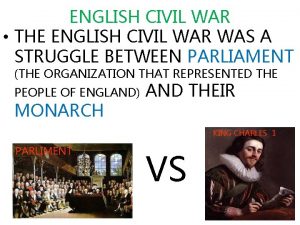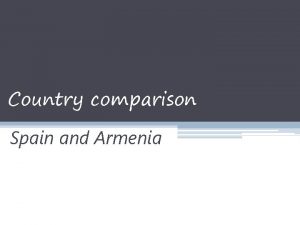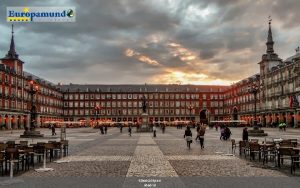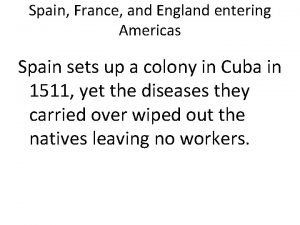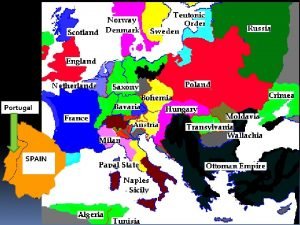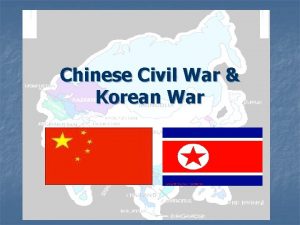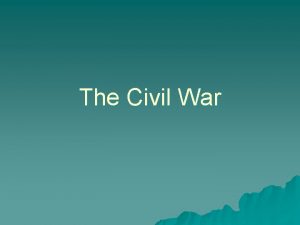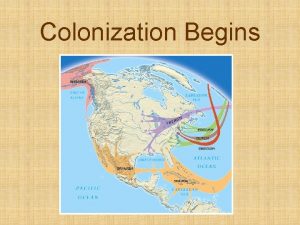England Versus Spain and the English Civil War















- Slides: 15

England Versus Spain and the English Civil War By Gabriel Fajl

England vs. Spain & English Civil War Philip II of Spain Son of Charles V, inherited the Spanish throne Huge empire: North and South America, the Iberian Peninsula, most of Italy, the Philippines, parts of the African and Indian coastline, and the Netherlands. Catholic leader, fought in the name of the church Two goals: Destroying the Muslims and the Protestants Reduced Muslim powers with gusto; under the command of Don Juan of Austria, the Holy League demolished the Ottomans, lead by Suleiman the magnificent, in the battle of Lepanto In the North, he wasn't so successful. He supported French revolts against Henry IV (“Paris is worth a mass”), a Protestant, even when he converted. Tried claiming England by marrying Mary I, but she died before having children, so he lost the claim. Didn't like England because it was Protestant, its pirates interrupted Spanish trade, it threatened some of his claims in the new world, and it supported the Dutch rebels. Further research: http: //www. nndb. com/people/229/000092950/ http: //www. britannica. com/EBchecked/topic/456081/Philip-II

Elizabeth I of England Daughter of Henry VIII, she inherited the English throne Protestant leader, religiously tolerant, and declared illegitimate by the Pope, she was despised by the Catholic rulers of the time. Remained unmarried all her life, but used her suitors to gain power, money, and influence in other countries. Despite being indecisive and cutting a very nice, forgiving figure, she was not to be dealt with. When Mary Queen of Scots, next up to the throne, began to pose a threat to her, she had her executed. Similar to Napoleon, she was a master propagandist. To learn more about her, I suggest the following sites: http: //tudorhistory. org/elizabeth/ http: //www. royal. gov. uk/historyofthemonarchy/kingsandqueensofengland/th etudors/elizabethi. aspx

Dutch Revolt and the Unofficial War Spain was strongly disliked in the Netherlands for a number of reasons, mainly hard taxing, little representation in gov. , the attempts to eradicate the Protestants in the area through an inquisition led by the Duke of Alva (The Iron Duke) http: //en. wikipedia. org/wiki/Fernando_%C 3%81 lvarez_de_Toledo, _3 rd_Duke_of _Alba(wikipedia did a great job on this one), etc. When revolt broke out, the Queen decided to indirectly support these rebels. She offered them ports in which to dock and also allowed her privateers, pirates in the eyes of the Spaniards, to attack Spanish trade ships and steal their routes. In 1568, English troops stole some Spanish ships carrying payment for the Duke's troops, and caused the sacking of Antwerp (A revolt by Spanish soldiers). The Spanish response was to seize some English trade ships docked in Antwerp. By 1585, the English and Spanish were having a mini cold war, and the English began hearing of the Armada. An advisor to the Queen named Robert Dudley, the Earl of Leicester, demanded that she intervene further in the Netherlands, but she was unsure, so she got him to do it for her. He named himself Governor-General further developing the tension between the two forces. England a threat to Spain, it's raids and support for the Netherlands was considered an act of war. Philip decided that he would root out the source of the problem. He attacked England with the Armada in 1588.

The Armada was made up of 130 boats, holding twenty-two fighting galleons, but it was destined to fail. In 1587 Sir Francis Drake (http: //www. bbc. co. uk/history/historic_figures/drake_francis. shtml) destroyed many of the ships while they were still harbored. What was to be food for the sailors rotted in the newly made and still damp barrels. The high admiral that was to run the show died in 1586 and a new one was chosen. However, he hadn't ever been to sea before and got very sea-sick. Finally, upon launching, the Armada hit a massive storm and had to come back to be repaired before attacking again. After finally launching the Armada, the English could do little to stop it, all in all their navy was ineffective. Duke of Alva Sir Francis Drake Robert Dudley The Armada

The Armada had to pick up some soldiers in the Netherlands before sailing for England though, so as they sat in port waiting for them, the English bombed them with old ships filled with gunpowder. These were called hell-burners. At this point the Armada was becoming weak, so they had two options, either a rush at the British, which couldn't happen because they didn't have enough power to run through the English blockade, or they could try to dock in Ireland go back to Spain. Option two was chosen, but those that survived the trip up to Ireland (remember, rotten supplies) were killed upon landing, they were seen as invaders. Landing in Spain, less than half the Armada remained, a loss of around 60 boats and twenty-thousand men. The English lost only one-hundred men, but seven-thousand died from disease.

In other words. . . Land in Ireland expecting support from fellow Catholics, are killed on sight. (5) Retreat in ruins, 50% of the Armada destroyed from bad luck and weather. (6) The Spanish Armada's Route Had to port here, in Calais, hell-burners, also the English blocked their way back into spain. (4) English begin attacking, pretty ineffective. (3) Docked here to repair the damages from the storm. (2) Left from here, immediately hit a storm. (1) Spanish failed due to lacking resources, bad weather, the English boats were more maneuverable, and they stopped to port for much too long

The reasons for all the fighting

The Revolution in England James I Inherits a debt of 400, 000 Pounds, leaves his rule vulnerable to change. The Gentry A group of quasi-nobles, 20, 000 strong, usually rich investors; they were the social leaders. Exposed a booming economy as theirs, wanted to be respected and listened to. The Puritans Protestants, they wanted to be even further from the Roman Catholic Church. Elizabeth didn't like them and in the end had to suppress the loudest of them. The problem wasn't that they wouldn't conform, it was that they wouldn't keep their beliefs to themselves, their preachers preached. The government under James was to be even more repressive and less tolerant, so the people and gentry alike began to question whether or not their system was working. The parliament's House of Commons filled with gentry who abused their powers to get what they wanted. Justified their opposition to the king through the use of law, and the kings apparent disregard for it The “Trew (true) Law of Free Monarchies, ” in which James I makes his stand for his Divine Right as a king (Click on the picture right there to see)

Petition of Rights Can be found here Charles I Confronted by Parliament “Petition of Right, ” (1628) no imprisonment without shown cause, no taxes without parliament's consent, no marshal law in times of peace, and no forced troop housing among civilians. Sent to the King by Edward Coke (on right). Charles agrees, but doesn't acknowledge, proceeds to dissolve parliament for the next eleven years. When he needs cash to fight off Scottish Calvinists, he turns to the parliament, who demands that he addresses their issues first. He didn't and civil war ensued. The Scottish refused to accept the reforms imposed upon them; by 1640 they occupied most of northern England. Charles made a new assembly later called the Long Parliament, it lasted thirteen years. It abolished the no-jury court system, ex. The Star Chamber, made imprisonment without shown cause illegal, no tax without parliamentary consent, and it demanded that parliament meet at least once every three years. The Puritans attacked the Anglicans and the existence of Church hierarchy. Passed the Grand Remonstrance; the removal of bishops from Parliament, the right for parliament to veto the king's appointments, and it asked that he stopped selling rebel lands. There was a group of Puritans known as Independents, they would have each congregation choose it's own form of worship independent of a centralized-authority, while it's opposite group, Presbyterians, wanted a centralized form of calvinist worship. The independents had Cromwell. Their goals were similar, and Cromwell allowed the Presbyterian style of thinking. Cromwell organized an army and put himself at it's head. It was religious and very disciplined, it was capable of nearly anything and beat out the royalists by 1645, in the battle of Naseby. Presbyterians and Independents fought, but with Cromwell's “New Model Army” he prevailed. The House of Lords is no longer a thing, and the House of Commons rid of all Presbyterians. The King is given a trial, and is executed. Cromwell is now head of the state, 1649.

Summary of last page Charles I lies to parliament and then dissolves it. Next, he asks it for money (eleven years later). They say no, Scottish Calvinists attack because they don't like his policies very much, occupy most of Northern England. The Puritans gain the upper hand on the royalist side and purge the courts and parliament of religious officials. England has been taken over by Puritans of two types, Independent and Presbyterian. The Independents take over with Cromwell at their head leading the “New Model Army. ” Cromwell becomes the new head of state.

The Long Parliament in session Execution of Charles I Long Parliament The Battle at Naseby

Oliver Cromwell now ruled England The parliament technically ruled, but Cromwell had all the real power. He had the army. Had to deal with absolutely radical ideas, for the time. The levellers wanted all adult males to vote and a parliamentary election every two years Another group, the Diggers, wanted a level of communism. No private property. The Society of Friends, the Fifth Monarchists, and other groups all began sending ideas to Cromwell and friends. Cromwell had two goals Religious freedom Constitutional Government Similar to Robespierre before he lost it The Parliament couldn't reform, so he couldn't achieve anything, they were too inefficient and didn't want any further change. He dissolved the Long Parliament in 1653 Ended up ruling by force Eleven major generals ruled the provinces Implemented media censorship Created a secret police In 1656, became the king Remained in command until he died

Little remained of the revolution, Charles II came to power, the monarchy persisted, the only change was that their would be no more royal courts, no more tax without consent, and habeus corpus had to be acknowledged. Beyond that, the gentry had gained an important voice and parliament became even more powerful than before. Works Cited Answers. com. Answers, n. d. Web. 19 Dec. 2012. "Beeldenstorm. " Wikipedia. Wikimedia Foundation, 17 Dec. 2012. Web. 19 Dec. 2012. "British Gentry and Nobility. " British Gentry and Nobility. N. p. , n. d. Web. 19 Dec. 2012. "Charles I and the Petition of Right. " - UK Parliament. N. p. , n. d. Web. 19 Dec. 2012. "Divine Right of Kings Definition: . " Divine Right of Kings Definition. N. p. , n. d. Web. 19 Dec. 2012. "Elizabeth I and Spain. " Elizabeth I and Spain. N. p. , n. d. Web. 19 Dec. 2012. "Elizabeth I and the Church of England. " Elizabeth I and the Church of England. N. p. , n. d. Web. 19 Dec. 2012. "Elizabeth I, Queen of England. " Elizabeth I, Queen of England. N. p. , n. d. Web. 19 Dec. 2012.

"Francis Walsingham. " Wikipedia. Wikimedia Foundation, 12 July 2012. Web. 19 Dec. 2012. "The Grand Strategy of Philip II. " Institute of Historical Research. N. p. , n. d. Web. 19 Dec. 2012. "John Singleton Copley. " John Singleton Copley. N. p. , n. d. Web. 19 Dec. 2012. "Philip II of Spain. " Wikipedia. Wikimedia Foundation, 17 Dec. 2012. Web. 19 Dec. 2012. "Sack of Antwerp. " Wikipedia. Wikimedia Foundation, 16 Dec. 2012. Web. 19 Dec. 2012. Smith, S. E. , and Bronwyn Harris. Wise. Geek. Conjecture, 07 Nov. 2012. Web. 19 Dec. 2012. "Spanish Colonies and the West Indies 1580 -1744. " Spanish Colonies and West Indies 1580 -1744. N. p. , n. d. Web. 19 Dec. 2012.
 England versus spain
England versus spain Why did england and spain go to war
Why did england and spain go to war Chapter 16 lesson 2 challenges to slavery
Chapter 16 lesson 2 challenges to slavery France spain map
France spain map Civil war first modern war
Civil war first modern war English civil wars timeline
English civil wars timeline English civil war mind map
English civil war mind map Cause of english civil war
Cause of english civil war England france spain
England france spain Civil rights webquest
Civil rights webquest Cold war 1947
Cold war 1947 Cotton diplomacy
Cotton diplomacy Unit 4 civil war and reconstruction
Unit 4 civil war and reconstruction Civil war and reconstruction study guide
Civil war and reconstruction study guide Civil war advantages and disadvantages chart
Civil war advantages and disadvantages chart Civil war advantages and disadvantages chart
Civil war advantages and disadvantages chart
